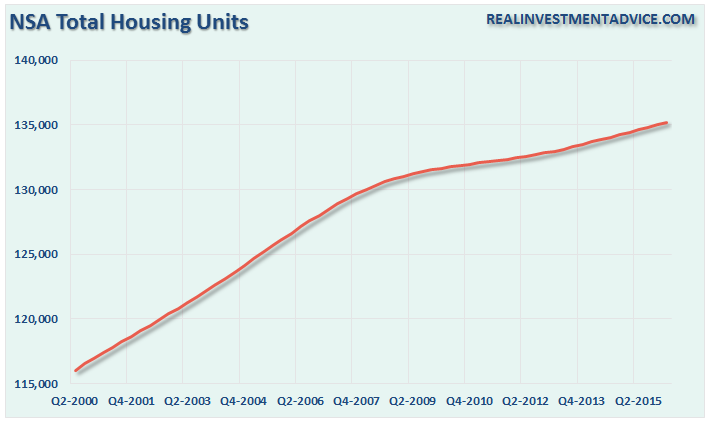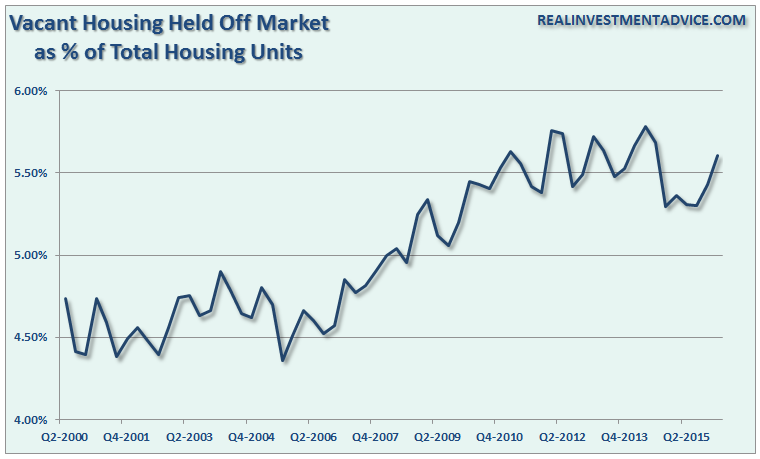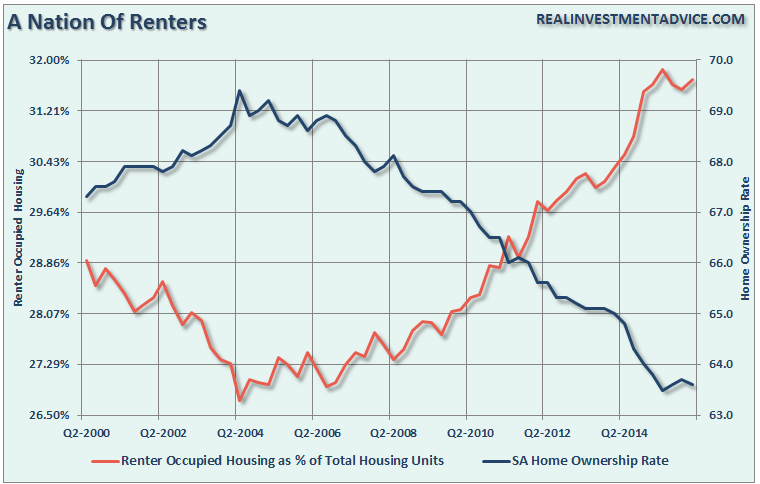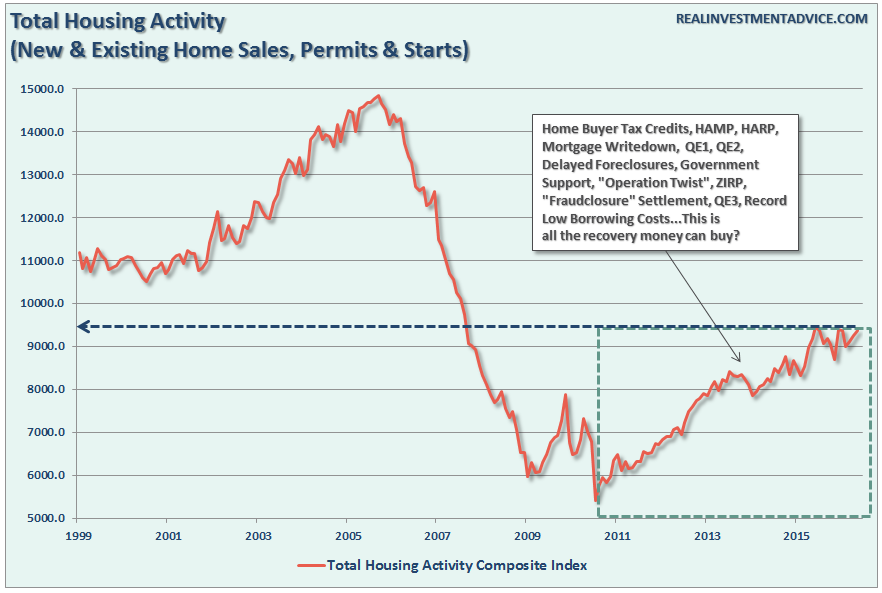Submitted by Lance Roberts via RealInvestmentAdvice.com,
The has been a rash of articles as of late suggesting there is a “new housing crisis” afoot. The issue this time, as it is suggested, is there is a “shortage” of homes for all the people that are wanting to buy homes causing prices to skyrocket out of reach. To wit:
“It hasn’t been this tough to be in the housing market since the financial crisis.
To recap the problem, the supply of housing, especially in the affordable entry-level segment, is not keeping up with huge demand from first-time buyers and existing homeowners looking to upgrade.”
It is true there is a lack of supply of homes currently on the market. However, the lack of supply is not being caused by a flood of millennial couples wanting to “buy” homes, but rather “all cash” buyers, particularly foreign buyers, snapping up properties for investment purposes.
Here is the evidence.
At The Margin
The problem with all of the analysis each month on the transactional side of housing is it only represents what is happening at the “margin.” The issue at hand, with respect to housing, is more than just the transactional side of the equation which is based on just the relatively few number of individuals, as compared to the total population, that are actively seeking to buy, rent or sell a home each month.
In order to understand what is happening in terms of “housing,” we must analyze the “housing market” as a whole rather than what is just happening at the fringes. For this analysis, we can use the data published by the U.S. Census Bureau which can be found here.
Total Housing Units
In an economy that is 70% driven by consumption, it is grossly important that the working age population is, well, working. As I discussed back in 2014:
“The mistake is assuming that just because initial claims are declining that the economy, and specifically full-time employment, is markedly improving. In any economy, it is ONLY full-time employment that matters as it provides enough income to support household formation, increased consumption and higher levels of personal savings rate which leads to increased productive investment. Unfortunately, as shown below, full-time employment as a percentage of the working-age population remains elusive despite falling jobless claims.”
Chart updated to current levels. As you can see, employment as a function of the overall working age population is only back to where we began as Bush was leaving office. (I have stripped out those in excess of 55 to eliminate the “baby boomers are all retiring” argument)
“Furthermore, the issue of ‘labor hoarding,‘ combined with the huge pool of individuals outside of the labor force, is an important phenomenon that obscures the real weakness in the underlying economy. These forces combine to reduce aggregate demand on businesses that in turn resort to productivity increases to stretch the current labor force further to protect profitability.”
To present some context for the following analysis we must first have some basis to work from. Our baseline for this analysis will be the number of total housing units which, as of Q1-2016, was 135,184,000 units. This was up from 134,409,000 in Q1-2015 for a total increase of 775,000 units which is roughly in line with annualized run rate of new one-family home sales during that period which averaged 506,000 units.
The chart below shows the historical progression of the seasonally adjusted number of housing units in the United States.
As an example, the most recent report of “existing home sales” showed that 5,530,000 homes were sold on an annualized basis in May. Since this is an annualized number, we must divide it by 12 months for the estimated seasonally adjusted number of sales for the month which was 460,833 homes. This number of home sales represents just 0.34% of the total number of homes available. This is what I mean by “activity at the margin.” When put into this frame of reference the “existing home sales” report doesn’t seem nearly as exciting.
Vacancy Rate
Out of the total number of housing units, some are vacant for a variety of reasons. They are second homes for some people that are occasionally used. They are being held off of the market for one reason or another (foreclosure, short-sell, etc.), or they are for sale or rent. The chart below shows the total number of homes, as a percentage of the total number of housing units that are currently vacant.
If a real housing recovery were underway, the vacancy rate should be falling sharply rather than rising in the latest quarter and hovering near all-time peak levels. Such does not suggest that there is a “rush to buy” by millennials at this point.
Owner Occupied Housing
Another sign of a failed housing recovery is in the number of “owner-occupied” housing. If there was indeed a crisis in “inventory” as suggested, the ownership rate would be rising sharply, rather than hitting historical lows.
Importantly, this is against the backdrop of a system of bailed out homeowners, historically low mortgage rates, and a flood of liquidity into the marketplace. Where is that “wealth effect” that was supposed to be created by the inflating asset prices?
Home Ownership
The simple reality is there has been very little actual recovery in housing, or for roughly 90% of the American population, which explains its weak contribution to economic growth. The chart of home ownership shows the overall lack of recovery the best.
At 63.5%, which is down from 65% in 2013, the current level of home ownership is the lowest that it has been since the early 1980’s.
“But Lance, the recent reports of sales, starts, permits, and completions have all improved in recent months.”
That is true, and those transactions must be showing up somewhere, right?
REO To Rent
While the Federal Reserve, and the current Administration, have tried a litany of programs to jump start the housing market nothing has worked as well as the “REO to Rent” program. Foreign investors, investment banks, and private individuals have flooded the market with cash to buy properties and convert them into rentals. This is clearly shown in the chart below which is the number of homes that are renter occupied versus the seasonally adjusted home ownership rate.
Do You See The Problem Here?
The one thing the “housing crisis” articles do get right is that prices are rapidly rising in the “hotbed” areas. As the REO-to-Rent game drives prices of homes higher, it reduces inventory and increases rental rates. This in turn prices out “first-time home buyers” who would become longer term home owners, hence the declining homeownership rate noted above.
The problem, and the next crisis, will be when the herd of speculative buyers turns into mass sellers – there will not be a large enough pool of qualified buyers to absorb the inventory which will lead to a sharp reversion in prices.
Maybe this is why the Federal Reserve, and the FDIC, and WallStreet have been lobbying to relax regulations put in place after the last housing bubble which required banks to have “skin in the game.” By removing those restrictions banks have now returned back to providing mortgages to unqualified buyers, pool them and sell them off to unwitting investors. Haven’t we watched this movie before?
While the surge in housing activity, which still remains at historically low levels as shown in the chart below, has certainly been welcome it should not be forgotten that it has taken massive bailouts, stimulus, and financial supports to induce such relatively small amounts of activity.
There is no argument that housing has indeed improved from the depths of the housing crash in 2010. However, that recovery still remains at very weak historical levels and the majority of drivers used to get it this point have begun to fade. Furthermore, and most importantly, much of the recent analysis assumes this has been a natural, and organic, recovery. Nothing could be further from the truth as analysts have somehow forgotten the trillions of dollars, and regulatory support, infused to generate that recovery.
The point here is that while the housing market has recovered – the media should be asking ‘Is that all the recovery there is?’
With 30-year mortgage rates below 4%, we should be in the middle of the next housing bubble with prices and home ownership rising. The question the media should be asking is “why?” Furthermore, what happens if the “bond market bears” get their wish and rates rise?
The housing recovery is ultimately a story of the “real” unemployment situation that still shows that roughly a quarter of the home buying cohort are unemployed and living at home with their parents. The remaining members of the home buying, household formation, contingent are employed but at lower ends of the pay scale and are choosing to rent due to budgetary considerations. This explains why household formation is near its lowest levels on record despite the “housing recovery” fairytale whispered softly in the media.
While the “official” unemployment rate suggests that the U.S. is near full employment, the roughly 94 million individuals sitting outside the labor force would likely disagree. Furthermore, considering that those individuals make up 45% of the 16-54 aged members of the workforce, it is no wonder that they are being pushed to rent due to budgetary considerations and an inability to qualify for a mortgage.
The risk to the housing recovery story remains in the Fed’s ability to continue to keep interest rates suppressed. It is important to remember that individuals “buy payments” rather than houses, so each tick higher in mortgage rates reduces someone’s ability to meet the monthly mortgage payment. With wages remaining suppressed, and a large number of individuals not working or on Federal subsidies, the pool of potential buyers remains contained.
The real crisis is NOT a lack of homes for people to buy, just a lack of enough homes for people to rent. Which says more about the “real economy” than just about anything else.
While there are many hopes pinned on the housing recovery as a “driver” of economic growth in 2013, 2014, 2015, 2016 – the lack of recovery in the home ownership data suggests otherwise.








